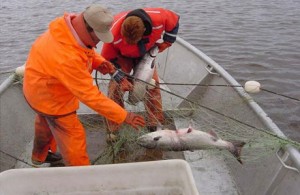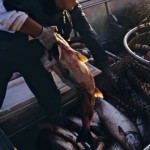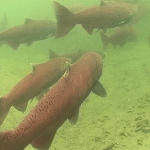Research on Chinook run timing
As of June 29 the Alaska Department of Fish and Game is reporting Chinook salmon throughout the length of the Yukon River in Alaska, from the Yukon Delta to Eagle on the Canadian border. Most Yukon River Chinook came home right on time this year, with the bulk of the run entering the river steadily throughout the month of June even though some Chinook took advantage of the early ice-out to enter the river during the last week of May.
Even with the early pulse of Chinook in May, the overall timing appears to be close to the long-term average, with an apparent mid-point somewhere on or between June 20 – 22. Around the middle of May when the marine ice went away, the prospects for a really early run were pretty good, but by the end of May when AOOS posted the final long-term timing forecast for the season, weather and sea conditions had turned cooler, causing the forecast to be just two days earlier than the long term average of June 21. The influence of a warm winter and early spring, culminating in near record high April, mean air temps was moderated by cool May air and sea surface temperatures which, when combined with the lack of wind, appears to have resulted in the close to average run timing.
Another factor in this year’s timing may be the wind, which can create marine conditions that may speed the entry of Chinook into the river. The 2014 run timing didn’t get much of a wind-driven boost, as the winds have been pretty tame by Northern Bering Sea standards, running below 20 mph for most of the migration (see the data). Fish were in the marine staging areas early, and first two pulses were through very early following a couple of mild wind events, then the run developed in a linear fashion until the big push on June 23, which followed sustained winds just below, but mostly above, 10 mph during June 18 – 22. Check the ADFG Daily Update for the details on how many Yukon River Chinook have been observed at different points along the river.
“When are the salmon coming?” And why is it so important to get the timing right?
Known for navigating the longest annual freshwater migration route of any salmon to reach their spawning grounds, Chinook salmon can start arriving on the Yukon River delta at almost any point in June. Over the past 50 years the first pulse of Chinook has occurred sometime between the 6th and the 26th of June. Traditional knowledge on the Yukon holds that spring weather conditions, including ice, temperatures and wind determine when in June the fish enter the river, but each spring brings a different combination of conditions, so pinning down a schedule for the arrival of the first pulse can be tricky. This year, air temperatures in April were especially warm and break-up of marine ice off the Yukon River delta was early, although May sea surface temperature were close to their long-term average.
Management of the Chinook salmon fishery is closely linked to expected time of arrival in harvest areas. When the migration begins earlier than expected, it’s reasonable for fishery managers to conclude that the run is stronger than it actually is, possibly resulting in over-harvesting near the river’s mouth and loss of harvest opportunities upriver. Likewise, in years when the first pulse of fish comes late, it is reasonable for fishery managers to conclude that the run is very weak, perhaps so weak that fishing needs to be slowed or stopped altogether.
Researchers from NOAA Fisheries and the Alaska Department of Fish and Game, with the support of the Alaska Ocean Observing System, have identified a combination of spring conditions that is closely related to the timing of Chinook salmon on the Yukon delta. Using percent spring ice cover between St. Lawrence Island and the Yukon delta, April air temperatures in Nome, and marine surface temperatures just offshore of the delta in May, the team predicted the timing of the run in the last two seasons to within three days of the actual timing before the start of each run.
Click here for a summary of historical and near real-time fish and environmental data for the 2014 Chinook salmon run in the Yukon River delta, Alaska Department of Fish and Game (ADF&G) Management Area Y-1.
-
Photograph by Deborah Mercy
-
Photograph by Deborah Mercy
-
Photograph by Deborah Mercy




